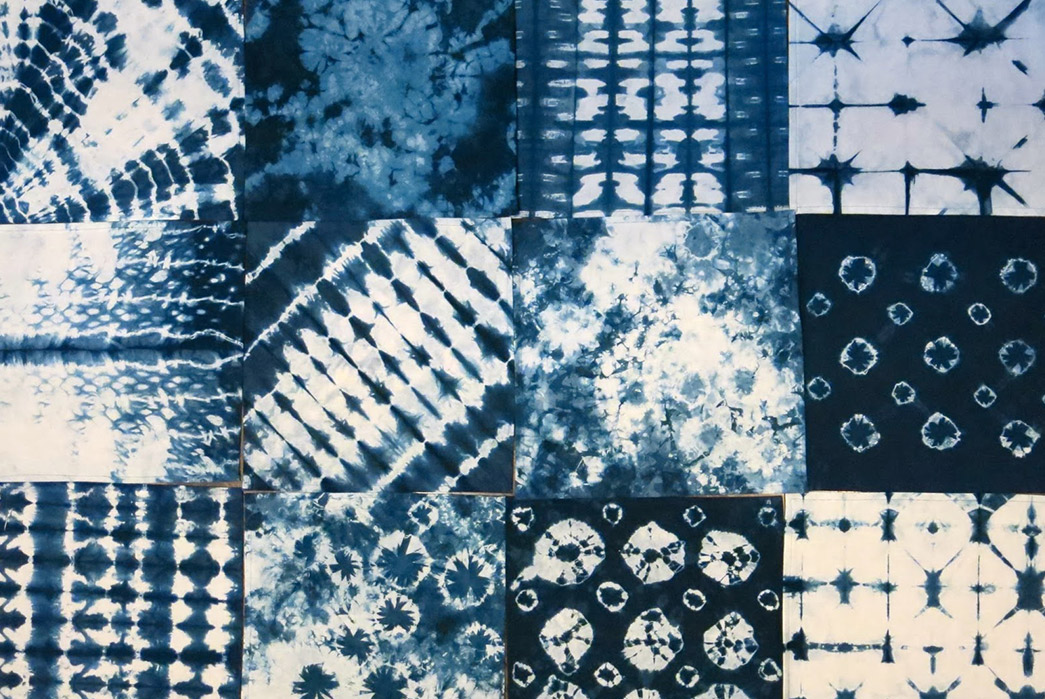Entry tags:
Indigo
The sunken walls of Firelei Báez's vision of Sans-Souci Palace are decorated in blue to recall the indigo dye used in West Africa, and at the end of the installation, in a separate space, is a giant painting by Stephen Hamilton, celebrating the use of indigo in textiles:

There are also samples of indigo-dyed fabrics created by Agnes Umeche, based on traditional designs.

And this informational plaque tells you a little more about Agnes Umeche and her work. (To read the text you'll have to click through and embiggen.)

Interestingly the indigo used in West Africa (Lonchocarpus cyanescens ) is different from the indigo used in Japan (Persicaria tinctoria), and both of those are different from woad (Isatis tinctoria) which also produces a blue dye. (Thanks goes out to the ninja girl for conveying that fact to me--I wouldn't have known!)
Here's some Japanese tie-dyeing--interesting to see the similarities with the West African tie-dyeing.

... and I happened to be using my copy of Lloyd Alexander's The Fortune Tellers as a hard surface on which to write a letter the other day, and I noticed that Trina Schart Hyman had made indigo borders around the edge of the cover design. NICE.


There are also samples of indigo-dyed fabrics created by Agnes Umeche, based on traditional designs.

And this informational plaque tells you a little more about Agnes Umeche and her work. (To read the text you'll have to click through and embiggen.)

Interestingly the indigo used in West Africa (Lonchocarpus cyanescens ) is different from the indigo used in Japan (Persicaria tinctoria), and both of those are different from woad (Isatis tinctoria) which also produces a blue dye. (Thanks goes out to the ninja girl for conveying that fact to me--I wouldn't have known!)
Here's some Japanese tie-dyeing--interesting to see the similarities with the West African tie-dyeing.

... and I happened to be using my copy of Lloyd Alexander's The Fortune Tellers as a hard surface on which to write a letter the other day, and I noticed that Trina Schart Hyman had made indigo borders around the edge of the cover design. NICE.

no subject
I visited a famous indigo-dyeing workshop in Kyoto called Aizen Kobo, http://www.aizenkobo.jp/, which perfectly illustrates how the former disdained handicrafts of peasants have to become high art (and priced accordingly) to survive. As soon as cheaper, better-functioning substitutes were available, people use them, and handmade products have to become tourist or art products. Textiles are one of the best examples. The richer classes in developed countries disdain synthetic fibres, but for many purposes they are genuinely superior in performance. They are cheaper, they can be washed and dried easily, good synthetic dyes don't fade as easily as natural ones, vermin aren't generally interested in eating nylon.
no subject
What you're saying about synthetic fabrics being cheaper and longer lasting makes me also think about the use of plastic generally. I've remarked to friends and family about what I call the Universal Warm-Weather Chair, which I see outdoors all over the world, both in places I've traveled to myself, but also whenever you get footage from some warm climate place. You can buy that here for like $5.00 a chair. At that price, it's not surprising that you find it everywhere. (In this tweet, I went on Google Street view and found versions of the chair around the world.)
no subject
Perfection of handicraft is still desirable in things made for the elite, though, and paid for accordingly.